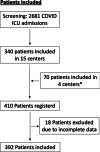Neurologic manifestations of COVID-19 in critically ill patients: results of the prospective multicenter registry PANDEMIC
- PMID: 35842675
- PMCID: PMC9287707
- DOI: 10.1186/s13054-022-04080-3
Neurologic manifestations of COVID-19 in critically ill patients: results of the prospective multicenter registry PANDEMIC
Abstract
Background: Neurologic manifestations are increasingly reported in patients with coronavirus disease 2019 (COVID-19). Yet, data on prevalence, predictors and relevance for outcome of neurological manifestations in patients requiring intensive care are scarce. We aimed to characterize prevalence, risk factors and impact on outcome of neurologic manifestations in critically ill COVID-19 patients.
Methods: In the prospective, multicenter, observational registry study PANDEMIC (Pooled Analysis of Neurologic DisordErs Manifesting in Intensive care of COVID-19), we enrolled COVID-19 patients with neurologic manifestations admitted to 19 German intensive care units (ICU) between April 2020 and September 2021. We performed descriptive and explorative statistical analyses. Multivariable models were used to investigate factors associated with disorder categories and their underlying diagnoses as well as to identify predictors of outcome.
Results: Of the 392 patients included in the analysis, 70.7% (277/392) were male and the mean age was 65.3 (SD ± 3.1) years. During the study period, a total of 2681 patients with COVID-19 were treated at the ICUs of 15 participating centers. New neurologic disorders were identified in 350 patients, reported by these centers, suggesting a prevalence of COVID-19-associated neurologic disorders of 12.7% among COVID-19 ICU patients. Encephalopathy (46.2%; 181/392), cerebrovascular (41.0%; 161/392) and neuromuscular disorders (20.4%; 80/392) were the most frequent categories identified. Out of 35 cerebrospinal fluid analyses with reverse transcriptase PCR for SARS-COV-2, only 3 were positive. In-hospital mortality was 36.0% (140/389), and functional outcome (mRS 3 to 5) of surviving patients was poor at hospital discharge in 70.9% (161/227). Intracerebral hemorrhage (OR 6.2, 95% CI 2.5-14.9, p < 0.001) and acute ischemic stroke (OR 3.9, 95% CI 1.9-8.2, p < 0.001) were the strongest predictors of poor outcome among the included patients.
Conclusions: Based on this well-characterized COVID-19 ICU cohort, that comprised 12.7% of all severe ill COVID-19 patients, neurologic manifestations increase mortality and morbidity. Since no reliable evidence of direct viral affection of the nervous system by COVID-19 could be found, these neurologic manifestations may for a great part be indirect para- or postinfectious sequelae of the infection or severe critical illness. Neurologic ICU complications should be actively searched for and treated.
Keywords: COVID-19; Critically ill; Intensive care; Neurologic manifestations.
© 2022. The Author(s).
Conflict of interest statement
Following conflicts of interests are reported: Albrecht Günther received speaker’s honoraria from Boehringer Ingelheim, Daiichi Sankyo, Pfizer, and Ipsen. Matthias Wittstock received speaker’s honoraria and consulting fees from Boehringer Ingelheim, Bayer Vital and Alexion pharma Germany. All other authors declare that they have no competing interests.
Figures


Similar articles
-
Risk Factors Associated With Mortality Among Patients With COVID-19 in Intensive Care Units in Lombardy, Italy.JAMA Intern Med. 2020 Oct 1;180(10):1345-1355. doi: 10.1001/jamainternmed.2020.3539. JAMA Intern Med. 2020. PMID: 32667669 Free PMC article.
-
Epidemiology, outcomes, and utilization of intensive care unit resources for critically ill COVID-19 patients in Libya: A prospective multi-center cohort study.PLoS One. 2021 Apr 30;16(4):e0251085. doi: 10.1371/journal.pone.0251085. eCollection 2021. PLoS One. 2021. PMID: 33930079 Free PMC article.
-
Incidence, risk factors and outcome of acute kidney injury in critically ill COVID-19 patients in Tyrol, Austria: a prospective multicenter registry study.J Nephrol. 2023 Dec;36(9):2531-2540. doi: 10.1007/s40620-023-01760-3. Epub 2023 Oct 14. J Nephrol. 2023. PMID: 37837501 Free PMC article.
-
Neurological manifestations associated with SARS-CoV-2 and other coronaviruses: A narrative review for clinicians.Rev Neurol (Paris). 2021 Jan-Feb;177(1-2):51-64. doi: 10.1016/j.neurol.2020.10.001. Epub 2020 Dec 16. Rev Neurol (Paris). 2021. PMID: 33446327 Free PMC article. Review.
-
Convalescent plasma or hyperimmune immunoglobulin for people with COVID-19: a rapid review.Cochrane Database Syst Rev. 2020 May 14;5(5):CD013600. doi: 10.1002/14651858.CD013600. Cochrane Database Syst Rev. 2020. Update in: Cochrane Database Syst Rev. 2020 Jul 10;7:CD013600. doi: 10.1002/14651858.CD013600.pub2. PMID: 32406927 Free PMC article. Updated.
Cited by
-
SARS-CoV-2 infects epithelial cells of the blood-cerebrospinal fluid barrier rather than endothelial cells or pericytes of the blood-brain barrier.Fluids Barriers CNS. 2023 Oct 24;20(1):76. doi: 10.1186/s12987-023-00479-4. Fluids Barriers CNS. 2023. PMID: 37875964 Free PMC article.
-
Thrombectomy of an Acute Ischemic Stroke in a Child with COVID-19 and MIS-C: Case Analysis and Literature Context.Children (Basel). 2023 May 9;10(5):851. doi: 10.3390/children10050851. Children (Basel). 2023. PMID: 37238399 Free PMC article.
-
No substantial neurocognitive impact of COVID-19 across ages and disease severity: a multicenter biomarker study of SARS-CoV-2 positive and negative adult and pediatric patients with acute respiratory tract infections.Infection. 2025 Apr;53(2):593-605. doi: 10.1007/s15010-024-02406-7. Epub 2024 Oct 1. Infection. 2025. PMID: 39352661 Free PMC article.
-
[Neurointensive care medicine and COVID-19].Nervenarzt. 2023 Feb;94(2):84-92. doi: 10.1007/s00115-022-01417-9. Epub 2022 Dec 15. Nervenarzt. 2023. PMID: 36520214 Free PMC article. Review. German.
-
The Impact of SARS-CoV-2 Infection on the Length of Stay in the Neuro-ICU:A Prospective Multicenter Cohort Study in Eight Neuro-ICU, China Between February and April 2023.Neuropsychiatr Dis Treat. 2024 Mar 30;20:765-775. doi: 10.2147/NDT.S447887. eCollection 2024. Neuropsychiatr Dis Treat. 2024. PMID: 38577632 Free PMC article.
References
Publication types
MeSH terms
LinkOut - more resources
Full Text Sources
Medical
Miscellaneous

